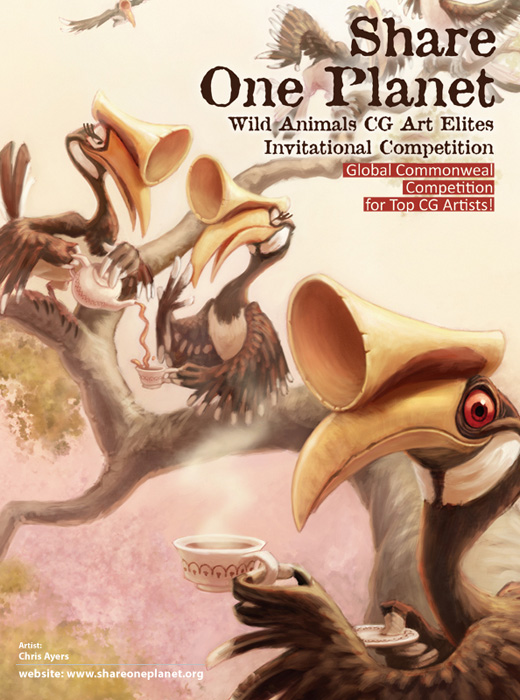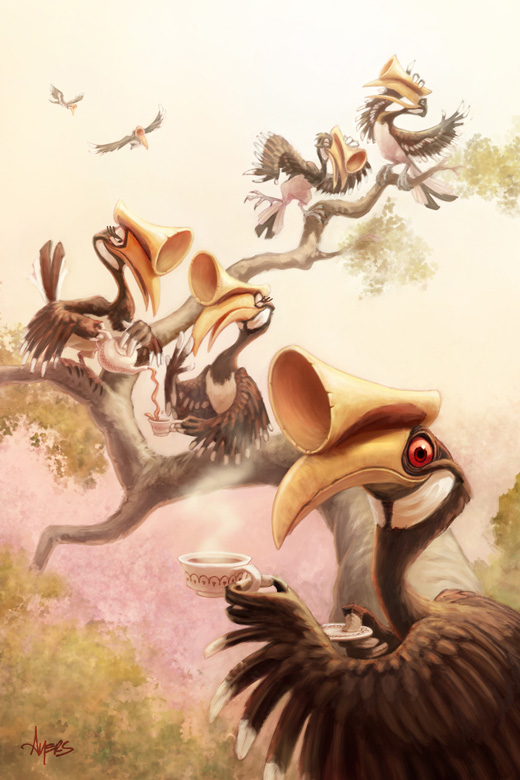Chris Ayers, a famous artist in CG industry, pays great attention and support to Share One Planet competition. Invited by the Organizing Committee, he painted the poster artwork of Herd Category for SOP.

Chris Ayers is a character designer from LA, USA. Animals in Chris’ artwork are vivid, expressive and unique. This poster for SOP is created with his customary cartoon style: a flock of Malabar Hornbill in very peculiar figure perched on a bulky branch, one of them holding a cup of tea. Their helmets are painted in an exaggerate way as trumpets from which music flows sweetly. The scene is like a family in afternoon teatime that enjoys drinking tea, chatting and listening to pleasant music together, all full of joy and warmth.
However, the real Malabar Hornbill race is not endowed with a life as delightful as those in the picture. They adopt an almost monogamous reproduction mode, thus one partner’s losing might destroy the whole family. Hunting and exploration to their habitat present a grave threaten to their survival. The number of wild Malabar Hornbill is very small now. We hope this poster by Chris can help people know Malabar Hornbill better and pay attention to their survival space. Let’s concern ourselves with all creatures with a grateful heart together with Chris. Give green back to our planet Earth to live in a vigorous and colorful world.

Poster artwork of Herd Category of Share One Planet competition, by Chris Ayers
Next is the interview with Chris Ayers, from SOP Organizing Committee:
1. In your creation, various animals fully deserve the title of the main character. When did you start to love animals? Is there any special chance that you start to pay close attention to animals?
I have had a love and fascination with animals for as long as I can remember. My parents tell me that I was entraced by them at a very early age and they have been a favorite subject matter to draw for my entire life. I am constantly amazed by them even now as an adult.
2. Anthracoceros coronatus (Malabar Pied Hornbill) is a special kind of bird which is not known well by people. Why did you choose it as the theme of this creation? What inspiration do you want to give us?
There were so many great and inspiring choices on the Share One Planet's list of species for this project that it was indeed a difficult decision. I brainstormed several ideas and created quick thumbnails for several different species but ultimately I settled on Anthracoceros coronatus. Hornbills have a lot of character to them with their striking coloration and, of course, the ornate casque above their bill. I thought they would be fun to draw.
3. On the subject of wild animals, most of the artists would like to portray their nature of valor, briskness and agility, but why did you use personified artistic language?
Although I greatly enjoy the challenge of creating artwork in many different styles, my natural tendency is to veer toward cartoon and caricature. I realized that many very talented artists would be participating in Share One Planet so I thought I would try to do something that would allow me to, as best possible, put my own unique stamp on it. The theme given to me by the contest organizers was "Herd" and required that I address the "societal nature" of my chosen species. While gathering reference material I came across several photos of treetops peppered with a fair number of hornbills so I knew they did gather in groups from time to time. I've often wondered what if a hornbill's casque was actually a musical HORN, so I made my hornbills with trumpet-shaped casques. Then the phrase "tea & crumpets" came into my head, for the afternoon snack that is traditionally enjoyed in England. I changed "crumpets" to "trumpets" which gave me the title of the piece, "Tea & Trumpets." It didn't take much for me to envision several jolly hornbills enjoying some polite conversation, afternoon tea, and a little music in the upper canopy of a forest.
Also, because of the historical presence of the British Empire in India (where Anthracoceros coronatus lives) I figured the idea of a troop of hornbills gathering for bit of afternoon tea was not as completely absurd as one might initially think!
4. We know that you have some unique life experiences. And after going through the invasion of illness, do you have some new understanding about your creation?
My experience dealing with cancer (acute leukemia) has definitely impacted my life in many ways. It certainly has heightened my appreciation for each day...each moment, really. I have always loved making art and facing cancer made me aware of just how unpredictable life can be, so it reinforced my belief that life is best lived when you are doing what you love to do. So, to that end, my cancer journey has inspired me to focus even more on art, especially my own artwork such as The Daily Zoo project. Going through the cancer experience was physically, emotionally, mentally, and spiritually grueling. However, I feel extremely fortunate that things have turned out well so far and that I have been able to discover many positive things that have come out of that darkness.
5. As one theme of the art, environmental protection has been emphasized by many artists. What do you think of environmental protection? And in what natural environment do you want to live most?
I think the conservation and protection of our planet's natural environments is one of humankind's biggest challenges...and should be one of our biggest priorities. I am encouraged by the many, many success stories that I hear but there is still so much work to be done. Still many battles to be fought. I wish more people would realize just how interconnected we all are - and not just humans, but insects, birds, fish, water, trees, etc. That might slow down or even reverse some environmental degradation. But the pressures of soaring human populations and greed are strong and will not be vanishing anytime soon. I think education is one of the conservation movement's strongest weapons in the fight to preserve and protect our planet's diversity and natural environments.
About Chris Ayers
|
|
|
Chris Ayers
Born and raised in Minnesota, Chris Ayers moved to Los Angeles shortly after college to pursue his lifelong dream of working in the movies. He was building a successful career as a character designer when he was diagnosed with leukemia (AML) in 2005. After a year-long period of treatment and recovery, he started a sketchbook called The Daily Zoo on the anniversary of his diagnosis. His goal was to combine two of his passions, animals and drawing, and create a sketch each day as a form of therapeutic healing. He has since published the first two year's worth of Daily Zoo images, still draws an animal-a-day, and celebrated five years of remission last summer.
|

